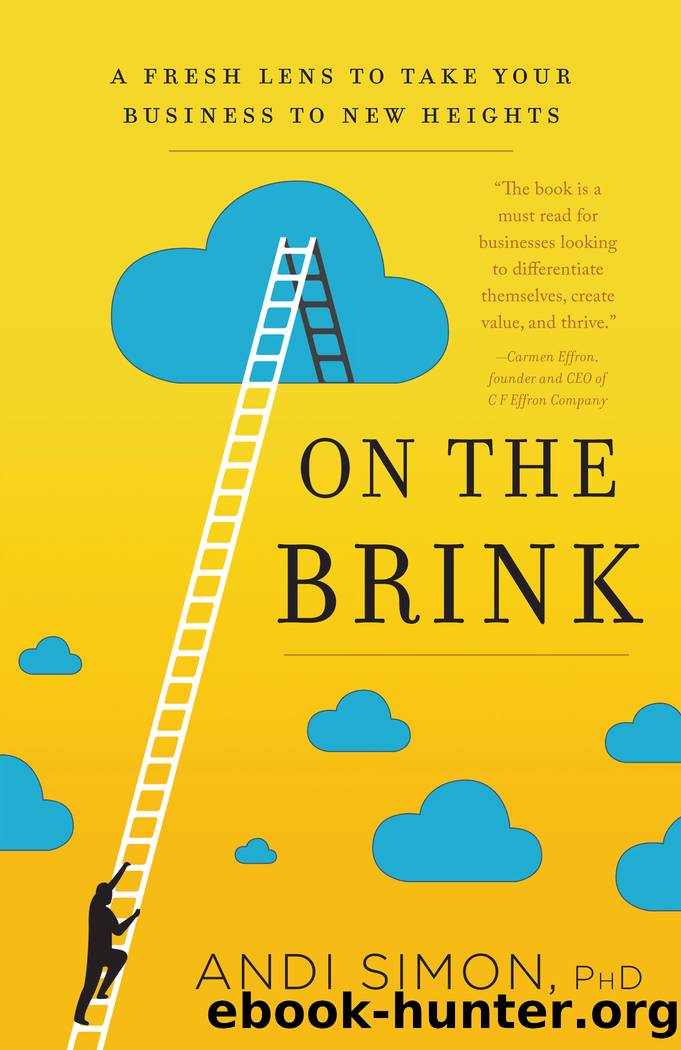On the Brink by Andi Simon

Author:Andi Simon
Language: eng
Format: epub
ISBN: 9781626342811
Publisher: Greenleaf Book Group Press
Published: 2016-01-14T16:00:00+00:00
First Things First: Lay the Groundwork
Once we were brought into the picture, we decided to approach this problem in three ways, all built around the fact that we didnât really know why someone would want to buy a hydration station, much less buy the companyâs innovative one.
First, I did some research on the water fountain, observed how people used it, and then found out what the literature said about why the water fountain was required in US building codes. Second, we set up a two-day retreat for the companyâs senior leadership, so that we could take them through our process of discovery. Third, we were asked to conduct an identical retreat with some of their key people to see what they could come up with.
Fortunately, it happened to be an opportune time to revitalize the drinking fountain. Year by year, Americans were drinking more water and fewer high-calorie soft drinks. By 2012, tap and bottled water accounted for thirty percent of the typical Americanâs liquid intake, up from sixteen percent two decades before, according to the Beverage Marketing Corporation. Nearly half of that water came from taps, including drinking fountains.
The origin of drinking fountains reflected the publicâs need for clean, cost-free drinking water. Back in the mid-nineteenth century in London, water provided by private companies was generally inadequate for the rapidly growing population, and the water was often contaminated. As a result, legislation made water filtration compulsory and moved water intakes on the River Thames above the sewage outlets. A movement to promote public drinking fountains followed, and soon an estimated seven thousand people a day were using them.
In the United States, in 1889, the then-small Kohler Water Works (now Kohler Company) in Wisconsin added drinking fountains to the faucets it already produced. And in 1896, a young man named Halsey W. Taylor lost his father to typhoid fever caused by a contaminated water supply. The would-be entrepreneur then dedicated his life to providing a safe, sanitary drink of water in public places. He founded the company that bears his name in 1912, and in 1926, he perfected and patented what is now known as the Double Bubbler, which projects two separate streams of water which converge to provide a fuller and more satisfying drink.
All of these inventions and innovations have nicely dovetailed with todayâs recent discussions about public water fountains. In 2012, the EPA began collaborating with US mayors âto reinvigorate our nationâs supply of public drinking fountainsâ and âpublicize the benefits of drinking safe, affordable tap water.â According to the agencyâs âBring Back the Water Fountain!â web page, promoting the public fountain is one way to foster an understanding of the tremendous efforts of approximately 155,000 public water systems in cities and municipalities throughout the United States. These public systems treat, filter, and deliver tap water to homes, businesses, and institutions 24 hours a day, 365 days a year, at an average cost of $0.002 per gallonâsignificantly less than the cost of a bottle of water, without any of the landfill issues.
Download
This site does not store any files on its server. We only index and link to content provided by other sites. Please contact the content providers to delete copyright contents if any and email us, we'll remove relevant links or contents immediately.
Zero to IPO: Over $1 Trillion of Actionable Advice from the World's Most Successful Entrepreneurs by Frederic Kerrest(4064)
Machine Learning at Scale with H2O by Gregory Keys | David Whiting(3640)
Harry Potter and the Goblet Of Fire by J.K. Rowling(3612)
Never by Ken Follett(3533)
Ogilvy on Advertising by David Ogilvy(3338)
Shadow of Night by Deborah Harkness(3177)
The Man Who Died Twice by Richard Osman(2811)
Book of Life by Deborah Harkness(2721)
My Brilliant Friend by Elena Ferrante(2704)
How Proust Can Change Your Life by Alain De Botton(2616)
0041152001443424520 .pdf by Unknown(2599)
Will by Will Smith(2581)
The Tipping Point by Malcolm Gladwell(2562)
How to Pay Zero Taxes, 2018 by Jeff A. Schnepper(2503)
Purple Hibiscus by Chimamanda Ngozi Adichie(2493)
Hooked: A Dark, Contemporary Romance (Never After Series) by Emily McIntire(2423)
Rationality by Steven Pinker(2150)
Borders by unknow(2119)
Daughter of Smoke and Bone by Laini Taylor(2083)
